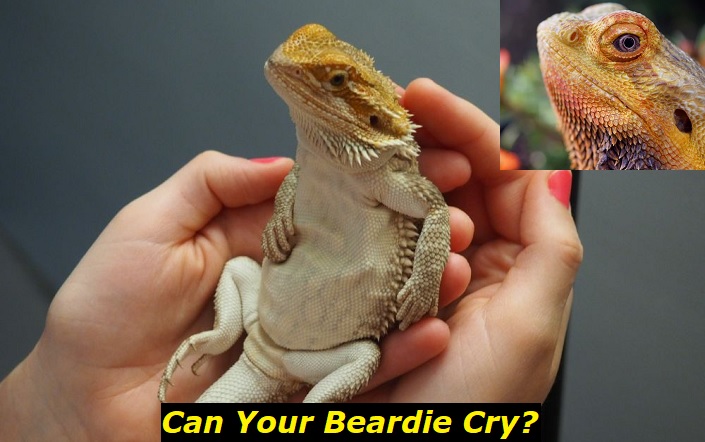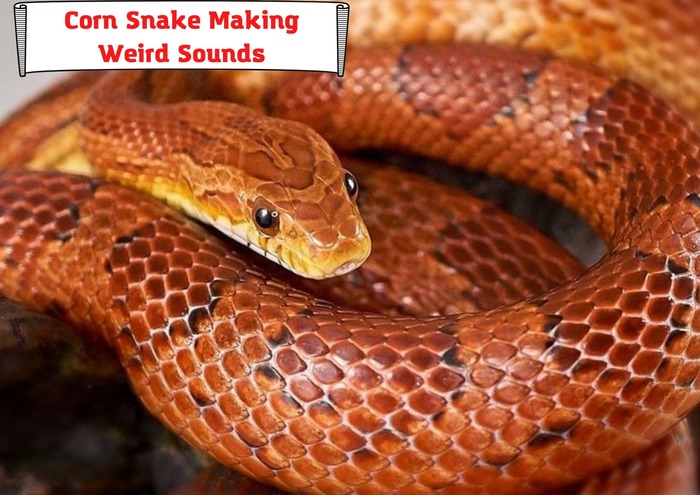It is common for reptiles to cry once in a while. Crocodiles are often referred to in terms of this trait. This is perhaps the same reason for the English saying, “Crocodile tears”. But the fact is that this feature is not limited to crocodiles or other dangerous reptiles out there.
Many beardie owners often ask, “Can bearded dragons cry? And if they do, what do their tears mean?”
This article reveals the reasons for this unusual behavior. It also discusses other interesting things about beardie emotions and how to understand them.

Can Bearded Dragons Cry?
Yes, bearded dragons can and do cry. This is common with many reptiles. Female beardies laying eggs sometimes cry. Also, both males and females sometimes cry in between meals. Others cry after the meal. The scenarios are numerous. But the truth remains that bearded dragons can cry like many other reptiles.
Why Do Bearded Dragons Cry?
There are many assumptions about why bearded dragons cry, but it is clear that they do not cry because they feel sad. Many times, bearded dragons and many other reptiles let out water from their eyes as a way of cleaning and protecting their eyes. Water flows from their tear duct to lubricate and clean their eyes.
This could be a response to the particles in the substrate entering their eyes.
Scientists also suggest the hiss of the warm air when food goes through the reptile’s sinuses to stimulate its tear glands. This leads to the tearing up as the tear glands empty water into the reptile’s eyes.
Although beardies cry, it is important to understand that this does not mean they are sad. It is normal for beardies to cry, and they usually stop at some point later. Many others do not even cry at all throughout their lifetime.
Can Bearded Dragons Cry from Feeling Sad?
No, bearded dragons cannot feel sad. More appropriately, bearded dragons can feel positive and negative emotional states, as is the consensus among scientists. But their tears are not because they feel sad.
Although bearded dragons do not have an advanced hypothalamus and other necessary structures to help them appreciate emotions, they can feel fear, boredom, anger, curiosity, and comfort. This essentially depends on the personality of each bearded dragon, but you can tell how happy your bearded dragon is by its level of arousal.
If your bearded dragon is frightened, the signs to notice will ideally include its unwillingness to be handled. It would want to be left alone in its enclosure. At other times, the color of its beard may change to black. But they do not feel sad. That is a feeling that only dogs and a few other domestic animals can feel.
How To Deal with Some Common Occurrences with Tears in Your Beardies Eyes
Ordinarily, tears in their eyes do not necessarily mean they are sad. As mentioned earlier, tears in your pet’s eyes are usually a means of cleaning the eyes of dust particles and other foreign materials.
Sometimes, tears in their eyes and other signs can help you understand the problem. At other times, bearded dragons, especially females, cry and become very weak when laying eggs. Here are a few tricks to deal with these situations:
Choose The Right Substrate Materials
It is important to choose the right substrate. Choosing the wrong substrate can lead to tears in your beardies’ eyes. Very loose substrates like tiny wood chips, mulch, crushed walnut, and even sand, in some instances, can leave dust in your pet’s eyes. When this happens, the usual reaction would be the stimulation of your bearded dragon’s tear gland. And the result will be watery eyes as a biological response to cleaning off the dust in your pet’s eyes.
You want to go for better substrate materials like ceramic tiles, reptile carpets, and clean paper towels. Tiles are great heat conductors and, most importantly, will not lead to dust settling in your pet’s eyes to trigger tears.
You can also use a rubber shelf liner and newspapers. The drawback of some of these good substrate materials is that they are not durable and can be easily destroyed by your pets. But you can deal with this by using decorations to hold down the newspapers. It would be best to keep a few more papers in the house if you need to change the substrate quickly.
Pay Attention to Gravid Female Bearded Dragons
It is common to find gravid females tearing up. This is usually accompanied by other disturbing symptoms like being too weak to walk, trying hard to hold her head up, and appearing to be exhausted.
You will have to call your vet immediately or take her to the vet if you find her in this situation. The reason is that if she is eggbound, the vet can help relieve her of the eggs.
Otherwise, you can do a few things to prevent her from going down. First, you want to soak her in a mixture of 50% Pedialyte and 50% water. This is important because the solution will help rehydrate her. After 30 minutes, take her out and keep her in her lay box.
After putting her in the lay box, you want to get her to eat some calcium. You can do this by mixing some calcium powder with a paste of apple and banana. Try to get her to eat it. You must get her to eat the paste as the calcium will help her bones.
You want to get the lay box under Ultraviolet lights. This will help her break down the calcium in her body.
Note: It would be best to use the tube UVB bulbs. The coil UVB lights do not emit sufficient UVB to aid the absorption of calcium. But the tube UVB lights do. So it would be best to get one.
This should stabilize the situation. After stabilizing the situation, you want to get her to the vet immediately.
Check the Parameters of Your Reptile Enclosure
Since the tears are usually a result of the tear glands being irritated, there could be other reasons apart from substrates that could cause the tearing up of your bearded dragon. So, checking every material part of your enclosure is crucial to stop the tears.
It is important to keep your bearded dragon’s enclosure very clean. You can clean routinely. There is no point in setting a special day for a thorough cleaning as you will need to clean the enclosure spot clean whenever there is a need.
Cleaning and sanitation are very important. You also want to sanitize the enclosure once every two weeks or less. You can do this using 20% bleach and 80% water solution. You want to soak the wood in the solution for no less than five minutes. After soaking, you want to take out the wood and bake it in the oven at 250oc for half an hour.
Another way to do this is to clean the decoration with hot water and common dish soap. After cleaning, you want to sanitize them with a 10% bleach solution. Rinse the decorations with water and leave them to dry.
To clean the enclosure, you would have to remove the substrate for a thorough cleaning. You want to scrub the tank’s interior with hot water and dish soap. After scrubbing, you want to rinse and leave the enclosure to dry.
Check the lighting too to ensure they get the right amount of light. As mentioned earlier, you need to install UVB lights to help your beardies metabolize the calcium you supply. For this, tube UVB light is better than coil UVB light. You also want to ensure that the temperature gradient is intact and that the enclosure remains in the right temperature range.
If, after all this, your beardie still tears up between meals, after meals, or during its egg-laying period, it would be best to visit a vet for a medical examination and professional advice.
Final Thoughts
It is common to find a bearded dragon cry, especially older beardies. While this may sound strange to new owners of bearded dragons, many experienced bearded dragon owners do not find it strange. But they may still find it disturbing.
The fact remains that there is no definite answer as to why beardies cry. But research has proved that the tears come from their tear glands. This tear gland is usually irritated by dust particles that get into the beardie’s eyes. When this happens, your reptile will usually respond to the stimuli by tearing up to clean its eyes.
Although tearing up is a means of lubricating the eyes to protect them, there are times when the tears in their eyes could mean something else. This is especially true when they exhibit other symptoms like loss of appetite, inactivity, and inability to move. When you notice these worrisome symptoms, it would be best to visit a vet immediately.
- Dubia Roach Egg Sack: How To Understand if It’s Healthy? - January 2, 2023
- How To Feed African Dwarf Frog While on Vacation? - December 26, 2022
- Baytril for Bearded Dragon: Here’s What You Should Know - December 19, 2022



